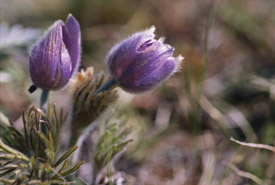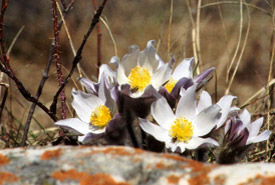
Prairie crocus (Photo by Karol Dabbs)
Prairie crocus
A flower of many names, prairie crocus is also known as gosling plant, pasque-flower, windflower and more. The furry perennial is not actually a crocus, but an anemone, belonging to the buttercup family.
The species can be found in northern parts of Canada, such as the Yukon and Northwest Territories, and in British Columbia east to Manitoba.
Instead of the robin, look for the prairie crocus this spring
In prairie provinces, this species is a great indicator that winter has gone and warmer weather is here to stay. Even if spring hasn’t completely sprung, the diminutive flower is able to withstand cold, wind and snow because of the tiny woolly-white protective hairs that cover it.
The legend behind the flower

Prairie crocus in full bloom (Photo by NCC)
The prairie crocus is the subject of many myths. One tale connects the creation of the species with the west wind, Zephyr. A forbidden love between Anemone, a nymph, and Zephyr caused an angry Flora (the goddess of flowers) to banish the nymph from her court. When the broken-hearted Anemone died, Zephyr persuaded Venus to change her body into a flower that would bloom when spring began.
Interestingly, "anemone" comes from the Greek word for "wind."
Provincial emblem
The prairie crocus was officially adopted as the official flower of Manitoba in 1906. The idea to name a provincial flower was first suggested by the Manitoba Horticultural Society and was followed by a vote among schoolchildren, who awarded the flower first place (prairie lily and wild rose came in second and third place, respectively).
Slow and steady
The prairie crocus relies on natural pollination by wind and bees in the wild but is often planted in Canadian gardens for its beauty and resilience through the seasons. However, this species is a slow-growing flower, so gardeners will have to wait three or four years to reap what they sow.





